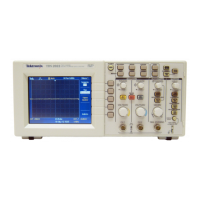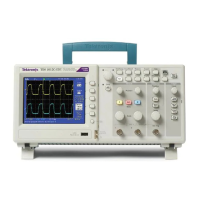Command Syntax
2−8
TDS200/1000/2000 Series Oscilloscope Programmer Manual
Message Terminators
This manual uses the term <EOM> (End of message) to represent a
message terminator.
GPIB End of Message Terminators. GPIB EOM terminators can be the
END message (EOI asserted concurrently with the last data byte),
the ASCII code for line feed (LF) sent as the last data byte, or both.
The oscilloscope always terminates messages with LF and EOI.
White space is allowed before the terminator; for example, CR LF is
acceptable.
RS−232 End of Message Terminators. RS-232 EOM terminators can be a
CR (carriage return), LF (line feed), CRLF (carriage return followed
by a line feed), or LFCR (line feed followed by a carriage return).
When receiving, the oscilloscope accepts all four combinations as
valid input message terminators regardless of the currently selected
terminator. When a combination of multiple characters is selected
(CRLF or LFCR), the oscilloscope interprets the first character as the
terminator and the second character as a null command.
Constructed Mnemonics
Some header mnemonics specify one of a range of mnemonics. For
example, a channel mnemonic could be CH2. You can use these
mnemonics in the command just as you do any other mnemonic. For
example, there is a CH1:VOLts command and there is also a
CH2:VOLts command. In the command descriptions, this list of
choices is abbreviated CH<x>.
Channel Mnemonics
Commands specify the channel to use as a mnemonic in the header.
Symbol Meaning
CH<x> 2−channel models: A channel specifier; <x> is 1 or 2.
4−channel models: A channel specifier; <x> is 1, 2,
3, or 4.

